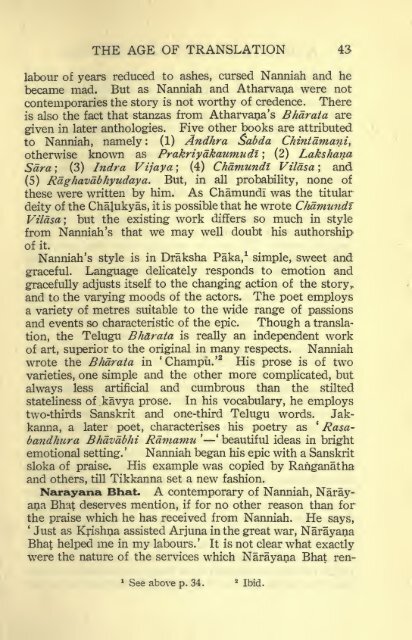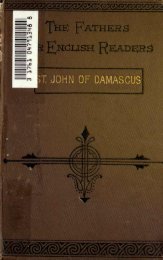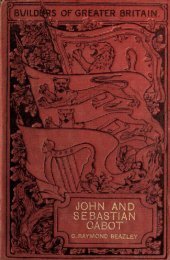A history of Telugu literature; - Cristo Raul
A history of Telugu literature; - Cristo Raul
A history of Telugu literature; - Cristo Raul
You also want an ePaper? Increase the reach of your titles
YUMPU automatically turns print PDFs into web optimized ePapers that Google loves.
THE AGE OF TRANSLATION 43<br />
labour <strong>of</strong> years reduced to ashes, cursed Nanniah and he<br />
became mad. But as Nanniah and Atharvana were not<br />
contemporaries the story is not worthy <strong>of</strong> credence. There<br />
is also the fact that stanzas from Atharvana's Bhdrata are<br />
given in later anthologies.<br />
Five other books are attributed<br />
to Nanniah, namely : (1) Andhra Sabda Chintdmani*<br />
otherwise known as Prakriyakaumudl ; (2) Lakshana<br />
Sara ; (3) Indra Vijaya ; (4) Chdmundl Vildsa ; and<br />
(5) Rdghavdbhyudaya. But, in all probability, none <strong>of</strong><br />
these were written by him. As Chamundi was the titular<br />
deity <strong>of</strong> the Chalukyas, it is possible that he wrote Chamundi<br />
Vildsa ; but the existing work differs so much in style<br />
from Nanniah's that we may well doubt his authorship<br />
<strong>of</strong> it.<br />
Nanniah's style is in Draksha Paka, 1<br />
simple, sweet and<br />
graceful. Language delicately responds to emotion and<br />
gracefully adjusts itself to the changing action <strong>of</strong> the story r<br />
and to the varying moods <strong>of</strong> the actors. The poet employs<br />
a variety <strong>of</strong> metres suitable to the wide range <strong>of</strong> passions<br />
and events so characteristic <strong>of</strong> the epic. Though a translation,<br />
the <strong>Telugu</strong> Bharata is really an independent work<br />
<strong>of</strong> art, superior to the original in many respects. Nanniah<br />
wrote the Bhdrata in 'Champu.' 2<br />
His prose is <strong>of</strong> two<br />
varieties, one simple and the other more complicated, but<br />
always less artificial and cumbrous than the stilted<br />
stateliness <strong>of</strong> kavya prose. In his vocabulary, he employs<br />
two-thirds Sanskrit and one-third <strong>Telugu</strong> words. Jakkanna,<br />
a later poet, characterises his poetry as '<br />
Rasa-<br />
' '<br />
bandhura Bhdvdbhi Rdmamu beautiful ideas in bright<br />
emotional setting.' Nanniah began his epic with a Sanskrit<br />
sloka <strong>of</strong> praise. His example was copied by Ranganatha<br />
and others, till Tikkanna set a new fashion.<br />
Narayana Bhat. A contemporary <strong>of</strong> Nanniah, Narayana<br />
Bhat deserves mention, if for no other reason than for<br />
the praise which he has received from Nanniah. He says,<br />
'<br />
Just as Krishna assisted Arjuna in the great war, Narayana<br />
Bhat helped me in my labours. '<br />
It is not clear what exactly<br />
were the nature <strong>of</strong> the services which Narayana Bhat ren-<br />
1 See above p. 34.<br />
2 Ibid.

















